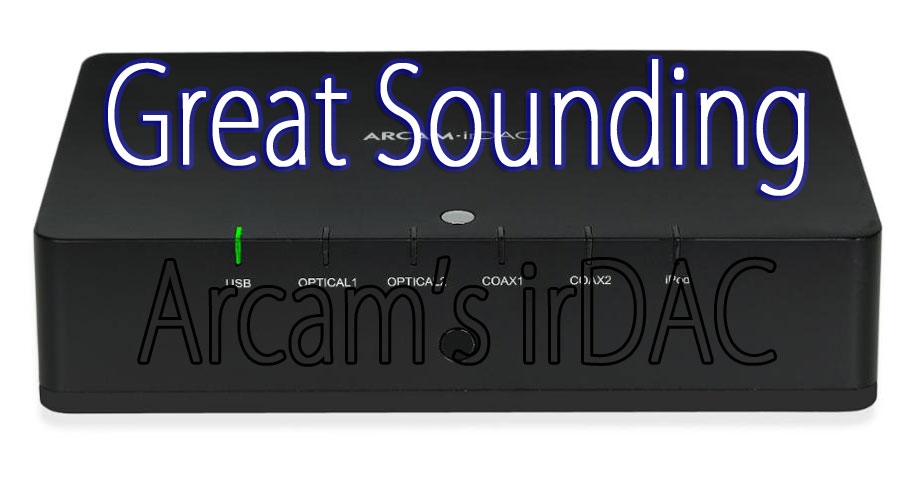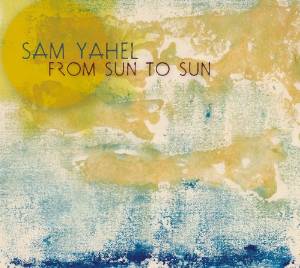Arcam irDAC

 I respond strongly to analog and rarely spend money on high resolution downloads these days, preferring instead to put my cash into tangible musical product. After spending a good part of the year bringing a 50 year old rim drive idler turntable back to use and subsequently built a 12” tonearm for it. Life’s not al analog, I do invest time ripping my own vinyl for personal consumption. Thankfully, my LP collection is in great shape, so there’s little need for post processing. The MSB Pad 1 analog to digital converter I use allows me a maximum resolution of 24 bit at 96kHz. I use a Mac Book Pro with Sound Studio software and tether with a handmade glass Toslink cable, since the Pad 1 can’t connect via USB. These rips sound quite good, but I’ve often wondered how good they really are. For convenience and ease of use, and because my primary Mac is quite far away from the audio system, I often play my digital files using my ‘iMod’ (a converted 80gb iPod Video) thru my custom-built in a cigar box dock, complete with OIMP Teflon caps. I arrived late to the iMod party just as high resolution downloads were beginning to happen. I got Red Wine Audio’s Vinnie Rossi to modify my 80 gb iPod Video gen 5.5 I to a capable digital player by bypassing the analog out. The iMod sounds good, great even, playing the rips I’ve made… I always thought they had promise.
I respond strongly to analog and rarely spend money on high resolution downloads these days, preferring instead to put my cash into tangible musical product. After spending a good part of the year bringing a 50 year old rim drive idler turntable back to use and subsequently built a 12” tonearm for it. Life’s not al analog, I do invest time ripping my own vinyl for personal consumption. Thankfully, my LP collection is in great shape, so there’s little need for post processing. The MSB Pad 1 analog to digital converter I use allows me a maximum resolution of 24 bit at 96kHz. I use a Mac Book Pro with Sound Studio software and tether with a handmade glass Toslink cable, since the Pad 1 can’t connect via USB. These rips sound quite good, but I’ve often wondered how good they really are. For convenience and ease of use, and because my primary Mac is quite far away from the audio system, I often play my digital files using my ‘iMod’ (a converted 80gb iPod Video) thru my custom-built in a cigar box dock, complete with OIMP Teflon caps. I arrived late to the iMod party just as high resolution downloads were beginning to happen. I got Red Wine Audio’s Vinnie Rossi to modify my 80 gb iPod Video gen 5.5 I to a capable digital player by bypassing the analog out. The iMod sounds good, great even, playing the rips I’ve made… I always thought they had promise.For this review, I relocated a turntable and set up the Arcam with my CD player, Oppo BRP-80 Blu-ray player and my Mac Book Pro close to the main rig. I’ve lived with the Arcam irDAC now for the past month and first listened with the supplied cables, curious how the supplied set up would sound to to an average consumer… a misstep to be sure. I logged ‘So far I’m not really impressed with the Arcam irDAC. It’s aggressive and almost rude, even after 4 days of break in with the XLO disk.’ My advice to buyers would be to ditch the included Arcam cables, they won’t do you any favors and could very well alter your first impression of the irDAC. Doing so paid off in my case… color me impressed.
I swopped in my Synergistic Research X Series Alpha Sterling with Active Shielding interconnects (all my SR MPC’s have been modified to near-Galileo performance) and started playing assorted audio files from the Mac Book Pro using Decibel software tethered by the original Kimber .5m USB cable – much better! Substituting the Transparent USB cable improved things even more. I also swopped out the stock coaxial cable for a Kimber .5 meter KCAG, which improved the sound coming from my CD player immensely, now used as a transport with the Arcam irDAC. This delivered greater body and depth the likes of which I’ve long been accustomed in the analog world. My modest Marantz CD-63 player always makes me smile and, when used as a transport with the Arcam irDAC, that smile widened.
For kicks and giggles, I connected my iPad Air, fired up the Onkyo HD app, made the in-app purchase of the Onkyo HD Performance Pack that is reported to play most high res files up to DSD. I was greeted with outstanding sound in doing so. My iPad Air is a 64gb model, so there’s adequate space for high resolution files. The iPad proved to be a nice front end in concert with the Onkyo HD software. Frankly, I was stunned how good things sounded. I downloaded ‘Audiogon Presents The Wake Up Your Ears Sampler Powered by Chesky’ and was greeted very nice quality sampler music tracks. Thru the Onkyo HD software on the iPad Air, they shined.


The Arcam irDAC is a very nice piece of gear, with heavy casework and a thick rubber-like base and weighted remote adding to it’s appeal.  There’s plenty to like here – a plethora of digital in’s and outs and a single pair of RCA analog outputs populate its rear panel – 2 coax, 2 optical, plus a USB for your computer and second for devices that even charges. Something for every source in your system. The irDAC has a top selector button and comes with a nicely weighted remote for use at a distance. The remote also includes controls for ease of use with supported ARCAM products.
There’s plenty to like here – a plethora of digital in’s and outs and a single pair of RCA analog outputs populate its rear panel – 2 coax, 2 optical, plus a USB for your computer and second for devices that even charges. Something for every source in your system. The irDAC has a top selector button and comes with a nicely weighted remote for use at a distance. The remote also includes controls for ease of use with supported ARCAM products.
 There’s plenty to like here – a plethora of digital in’s and outs and a single pair of RCA analog outputs populate its rear panel – 2 coax, 2 optical, plus a USB for your computer and second for devices that even charges. Something for every source in your system. The irDAC has a top selector button and comes with a nicely weighted remote for use at a distance. The remote also includes controls for ease of use with supported ARCAM products.
There’s plenty to like here – a plethora of digital in’s and outs and a single pair of RCA analog outputs populate its rear panel – 2 coax, 2 optical, plus a USB for your computer and second for devices that even charges. Something for every source in your system. The irDAC has a top selector button and comes with a nicely weighted remote for use at a distance. The remote also includes controls for ease of use with supported ARCAM products.The Arcam irDAC has shown me just how good my home grown rips are. The sound it produces is very grounded, with tight bass, fluid highs, transient snap and decent soundstage depth and width. In contrast, my HRT Music Streamer ll sounds rather flat, lacking the depth and imaging capacity of the irDAC, though it does provide a solid bass foundation. Perhaps that’s why digital has never truly captivated me… the Arcam irDAC simply sounds more real. While it’s not fair to compare two units with such different price points, doing this helped me identify the Arcam’s strengths.

CDs sound great playing thru the irDAC. Sam Yayel’s ‘From Sun To Sun’ (Origin Records 2011) is a treat for the ears, presenting some of the most sensitive percussive accompaniment I’ve heard. Mack Wilberg’s ‘Requiem,’ from Intellectual Reserve, Inc. 2008, remains a seasonal favorite, providing both a orchestral and massive choral accompaniment with aplomb. I’ve heard this work performed live, an experience seared into memory with the shear numbers of singers that climbed to the stage. The Arcam did a great job of presenting this massive score.

I ripped Vanessa Fernandez ‘Use Me’ 45rpm double vinyl offering 45 rpm double vinyl release (on Groove Note Records 2014) to a single 24 bit/96kHz file, and played the result thru the irDAC. Sublime. Percussive pacing, tight imaging and a decent soundstage – all comparing favorably to the source vinyl. Next up, some SACD rips at the same rate since the OPPO won’t allow me to use it as a transport with the irDAC at its high res data rate except thru analog outputs. Again, the Arcam shined. My rips sounded even better than I had hoped.
The irDAC is a quality piece I’ll miss after its return. It is a great audio anchor to a good system.




Specifications:
- DAC: TI PCM1796
- Inputs: USB, SPDIF, optical, iPod
- Frequency response: 10Hz — 20kHz, ±0.1dB
- Total Harmonic Distortion: + Noise 0.002%
- Signal-to-noise ratio (A –Weighted): 112dB (24-bit)
- Line output level: 2.2Vrms
- Supported sample rates: 44.1kHz, 48kHz, 88.2kHz, 96kHz, 192kHz
- Supported bit depths: 16-bit, 24-bit
- Power requirements: 7W max
- Dimensions: (wxdxh, mm) 190 x 120 x 44
Price: $799.00
Website:www.arcam.co.uk/products,rSeries,USB-DACs,irDAC.htm
Stereo Times Masthead
Publisher/Founder
Clement Perry
Editor
Dave Thomas
Senior Editors
Frank Alles, Mike Girardi, Russell Lichter, Terry London, Moreno Mitchell, Paul Szabady, Bill Wells, Mike Wright, and Stephen Yan,
Current Contributors
David Abramson, Tim Barrall, Dave Allison, Ron Cook, Lewis Dardick, John Hoffman, Dan Secula, Don Shaulis, Greg Simmons, Eric Teh, Greg Voth, Richard Willie, Ed Van Winkle, Rob Dockery, Richard Doran, and Daveed Turek
Site Management Clement Perry
Ad Designer: Martin Perry





Be the first to comment on: Arcam irDAC